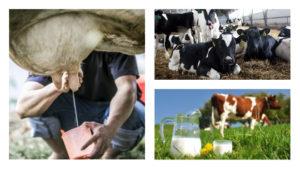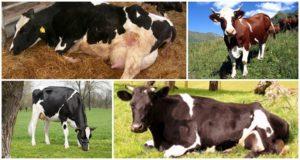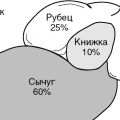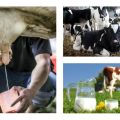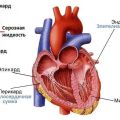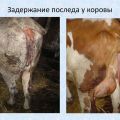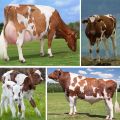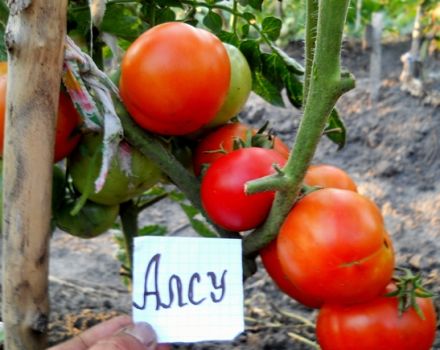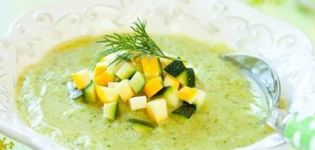Anatomy of the structure of the skeleton of a cow, names of bones and internal organs
Each farmer should know the structure of the internal organs and the features of the skeleton of a cow in order to help the animal on his own, if necessary. Knowledge of cattle anatomy allows us to assess the usefulness of the development of calves, to identify fractures and internal injuries in animals, to keep the health of the herd under control. Anatomical knowledge is especially necessary for owners of medium-sized farms who do not have a veterinarian under the authority.
Head structure
The cow has a large head, consisting of a cranium, eyes, ears, dentition, nose.
Skull
The cow's skull is divided into 2 sections: the first protects the brain, the second forms a muzzle with eye openings, nasal passages, and jaws. In a calf, the sections are equal in volume, as the bull grows up, the facial section increases, the cerebral section does not change.
The cranial skeleton of a cow is formed by 13 paired (symmetrically located on both sides) and 7 unpaired bones. Paired ones make up the crown, forehead and temples, unpaired ones - the nape, wedge-shaped and inter-parietal parts. List of cow skull bones:
- paired cerebral region - frontal, parietal, temporal;
- paired facial - lacrimal, palatine, zygomatic, maxillary, mandibular, intermaxillary, nasal, pterygoid, superior turbinate, inferior turbinate;
- unpaired cerebral - wedge-shaped, occipital, inter-parietal;
- unpaired facial - sublingual, trellised, opener.
Eyes
The cow's visual organs are located symmetrically in the face of the skull. Cattle have monocular vision. The eyeball is located in the orbit, it is rounded, slightly convex on the outside, covered with three membranes. Internally, the organ is divided into the vitreous body, anterior and posterior lobes. Eyelashes - protection against mechanical stress. The lacrimal glands secrete fluid to keep the eyes moist. The iris in cattle is, in most cases, brown.
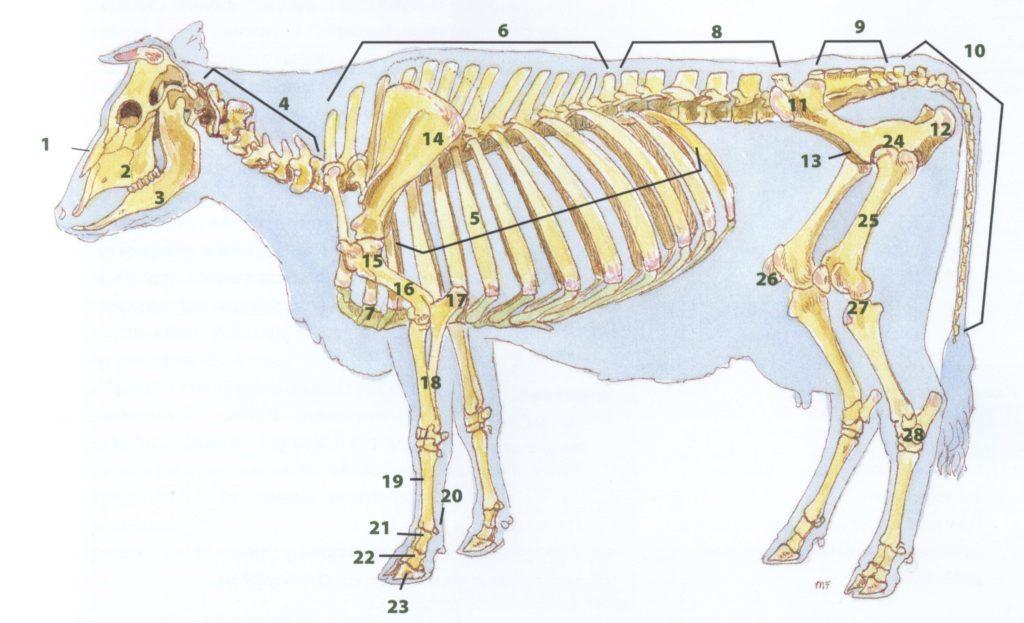
Teeth
The calves have 20 milk teeth. Adults have 32 teeth. The jaws of the cow are adapted for chewing plant foods. The incisors are long, directed forward, with sharp edges, growing from the lower jaw, intended for cutting grass. Chewing is carried out in a circular motion of the lower jaw.
Hearing aid
Cattle have good hearing. The cow's hearing organ consists of the outer, middle, inner ear. The auricle is mobile, composed of muscle and cartilaginous tissues.Inside, the ears are made up of the ossicles and the eardrum.
How the skeleton works
Cattle have a strong, heavy skeleton. In bulls, the skeleton is more massive than in females, which is due to the greater muscle mass.

The skeleton of a cow consists of 2 parts:
- axial - cranium, spinal column, chest;
- peripheral - front and hind limbs.
Spine
The cow has 50 vertebrae, the axial part of the skeleton includes:
- 7 cervical vertebrae;
- 13 chest;
- 6 lumbar;
- 5 sacral;
- 19 tail.
The cervical vertebrae are the most mobile, connecting the skull and sternum. Withers - 7th cervical vertebra. The pectoral skeleton is the least mobile, it is the basis for the attachment of the ribs. Ribs - 13 pairs of flat bones that form the ribcage, protecting the heart and lungs from injury. In a cow, 5 rib pairs are connected by cartilage, 8 pairs are free.

The description of the thoracic skeleton should be understood in more detail, since the anatomy of the rib plates is not the same. The front ribs are strong and strong. The middle ones are widened towards the edge. The hind ones are short and curved. The last costal pair is attached only to the spine, does not reach the sternum.
Limbs
The skeleton of the forelimb of cattle consists of the scapula, humerus, forearm, and hand. The hand is formed from the metacarpal, carpal, phalanx bones. The phalanges of the toes form the hooves. The skeleton of the forearm is formed by the ulna and radius. The radius of the cow is better developed than the elbow.
The skeleton of the back of the body - pelvic bones, thigh bones, legs, feet. The femur is the largest bone in a bovine skeleton.
The structure of internal organs and systems
A cow lives a full life thanks to properly functioning internal organs and systems.
Muscle
When a calf is born, up to 80% of its body weight falls on the musculoskeletal system, which includes the skeleton and muscle tissue. In an adult cow, skeleton and muscles make up about 60% of the weight.
The musculature of bulls includes 250 muscles. The full functioning of the body is ensured by the fact that the external muscular covering of the skeleton and the internal smooth muscles form a functional complex.
In section, the musculature of a cow consists of several main muscle groups:
- facial - regulate facial expressions, movements of the eyes, nostrils, lips;
- chewing - move the jaws;
- shoulder - move the shoulder skeleton;
- sternum - support the organs of the chest cavity, expand and shift the chest during breathing;
- vertebrates - move the head, neck, spine, lumbar, pelvic, caudal parts of the skeleton;
- abdominal - support the abdominal organs, provide defecation, urination, the work of the digestive tract, uterine contractions.
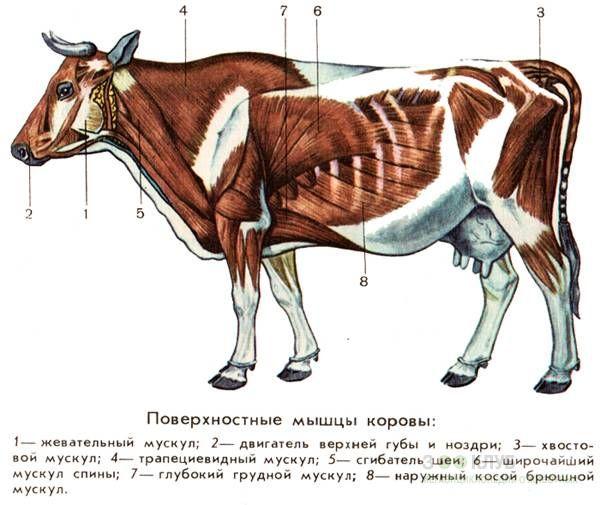
Nerves
Signals from the senses are sent through nerve fibers to the brain, where they are processed. Brain impulses are sent to the senses, carry information about how to respond to stimuli.
The cow's nervous system is divided into several departments with functional features:
- The brain is the basis of the central nervous system, which controls all vital processes. A cow's brain weighs 550 g, is divided into equal hemispheres, covered with a shell - bark.
- The spinal cord is an extension of the central nervous system and is located in the canal of the vertebral skeleton. Reaches 1.8 m, controls unconditioned reflexes.
- Peripheral nerves - connectors of the brain with muscles, blood vessels, abdominal and secretory organs.
- Autonomic nerves are the nodes that control external secretion, the functioning of the organs of vision and respiration, pelvic and abdominal organs, smooth muscles.
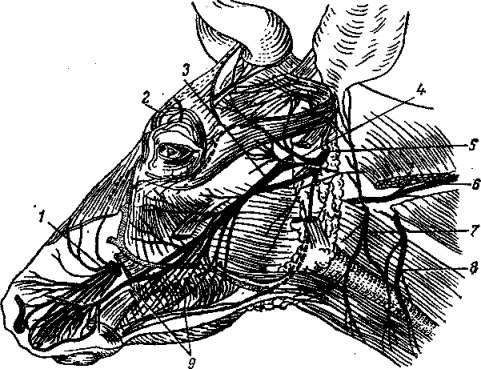
Respiratory organs
The lungs of cattle are large, since the body of large animals requires a significant supply of oxygen. The lungs of a cow weigh 3500 g, a bull 4800 g. The cow's right lung is larger than the left. On the left side of the chest there is a large heart, which reduces the volume of the lung, and in some individuals it almost divides it into two parts.
Heart and blood vessels
A cow has a four-chambered heart: 2 atria at the top, 2 ventricles at the bottom. Through the vessels, the blood carries hormones and immune agents, delivers nutrients, oxygen, and liquid to tissues and organs. Diagram of the cow's heart:
- When the heart muscle relaxes, the atria and ventricles fill with blood.
- The atria contract - the phase is called systole. Blood flows into the ventricles.
- The atria relax. The valves that separate them from the ventricles slam shut.
- The ventricles contract. During systole, blood is ejected from the left ventricle into the aorta, from the right ventricle into the pulmonary artery.
- This is followed by diastole - relaxation of the organ, filling it with blood.
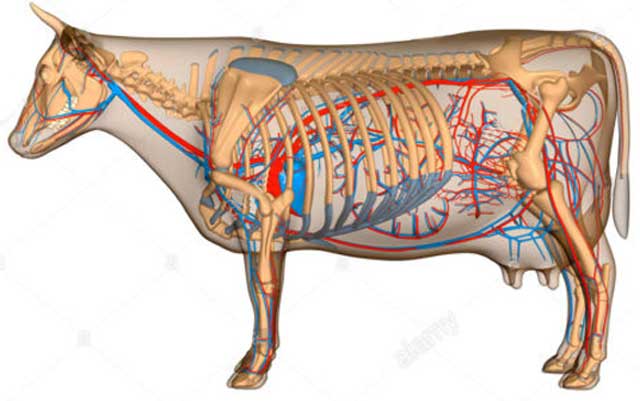
Digestive organs
A cow's digestive system consists of several organs:
- Oral cavity. In it, food is chewed with the release of saliva.
- The esophagus is the tube through which chewed food moves into the stomach.
- The stomach is the organ for digesting and breaking down food particles.
- Pancreas. Located on the side of the stomach in the right hypochondrium. Produces digestive juices.
- Small intestine. Consists of the duodenum, jejunum, ileum. It absorbs nutrients from the digested food.
- Colon. Consists of blind, colon, rectum. It ferments the food mass, forms feces, removes it outside through the anus.
The length of the cow's intestines is 63 m, which is 20 times the body length. The food that has entered the digestive tract is digested for 2-3 days. A healthy cow excretes 20-40 kg of feces per day.

Stomach structure
Coarse plant foods are digested in the cow's stomach, which has 4 sections:
- scar;
- mesh;
- a book;
- abomasum.
The rumen of a cow holds 200 liters. Here, beneficial microflora breaks down fiber. The animal regurgitates the coarsest parts of the food so that they re-enter the rumen and are thoroughly digested. Grid with a honeycomb structure with a volume of 10 liters. Here the food mass stays for 2 days, is processed by microorganisms. Further, the food enters the book, which consists of many thin plates. Here, fluid is absorbed for 5 hours. In the abomasum, containing 10-15 liters, digestion is completed, the food mass is exposed to the action of the digestive juice.
Urinary organs
The cow's excretory system consists of the kidneys, ureters, bladder and urethral canal.
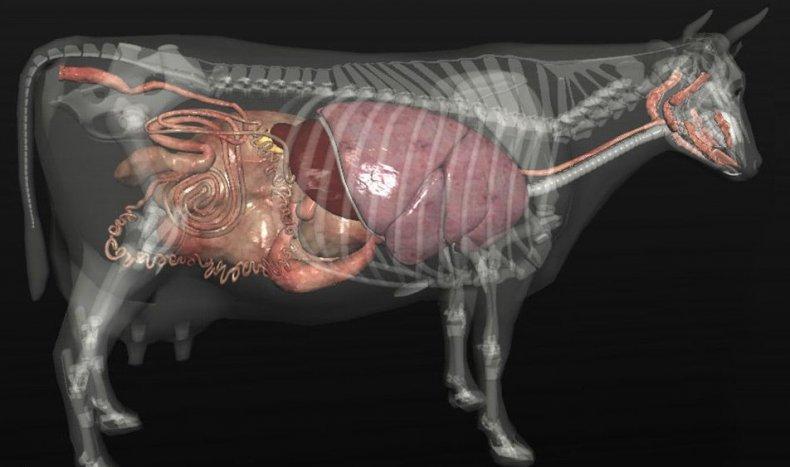
The kidneys are a filtration organ. Cleansing the blood from waste products, they produce 20 liters of urine per day. Urine is sent through the ureters to the bladder, where it accumulates to go out through the urethra.
Reproductive system
The genitals of bulls are intended for the synthesis of sperm and the fertilization of eggs:
- penis - organ of urination and sperm excretion;
- prepuce - the shell of the outer edge of the penis;
- urethral canal;
- the vas deferens - a channel for the release of semen;
- spermatic cord - an abdominal fold containing the vas deferens;
- testicles - organs for the synthesis and accumulation of sperm;
- The scrotum is the skin sac that contains the testicles.
The female's reproductive system is designed for bearing and giving birth to offspring:
- vagina;
- the clitoris is an enhancer of uterine contractions;
- labia;
- the uterus is a muscular organ that contains the developing embryo;
- the fallopian tubes, through which the egg moves from the ovaries;
- ovaries are the storage organs of eggs.
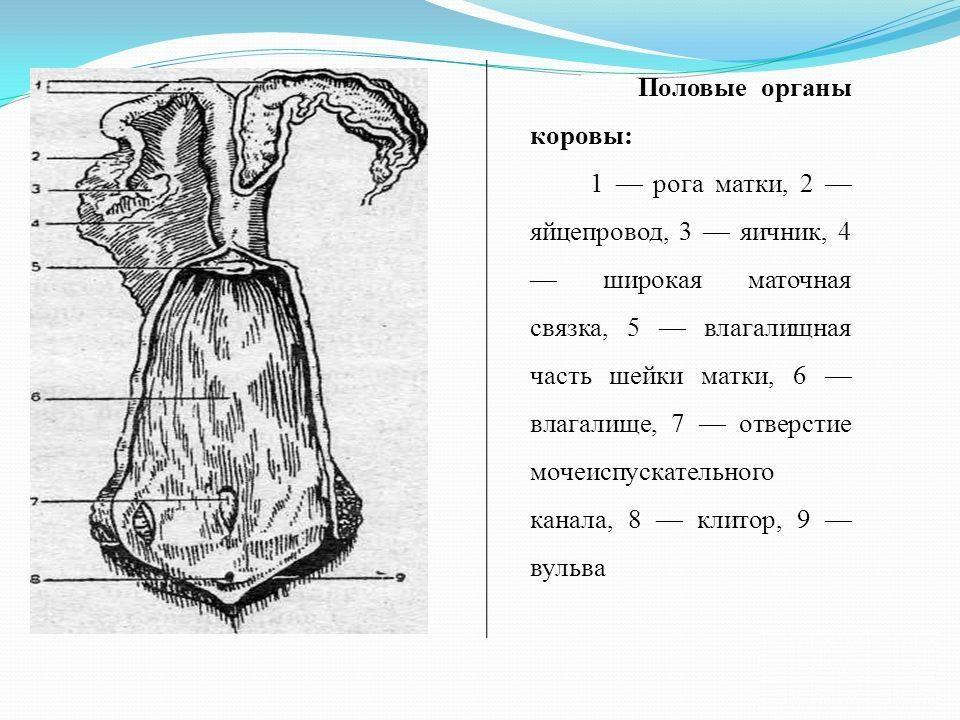
Udder structure
The udder of a cow is divided into 4 parts. Each mammary gland ends with a nipple. That is, a cow has 4 teats.
Circulatory system
The mammary glands are abundantly entangled with blood capillaries that carry oxygen and nutrients.
Lymph supply to the body
Lymphatic vessels pass through the udder apart from the blood capillaries. They supply tissues with fluid, remove decay products.
Lymph nodes are located on both sides of the udder. Their swelling signals the onset of mastitis.
Nerve endings
Nerve endings are abundant in the mammary glands. They transmit signals to the brain about the need to synthesize and excrete milk. The response signals from the brain make the cow anxious, humming to prompt the owner that it is time for milking.
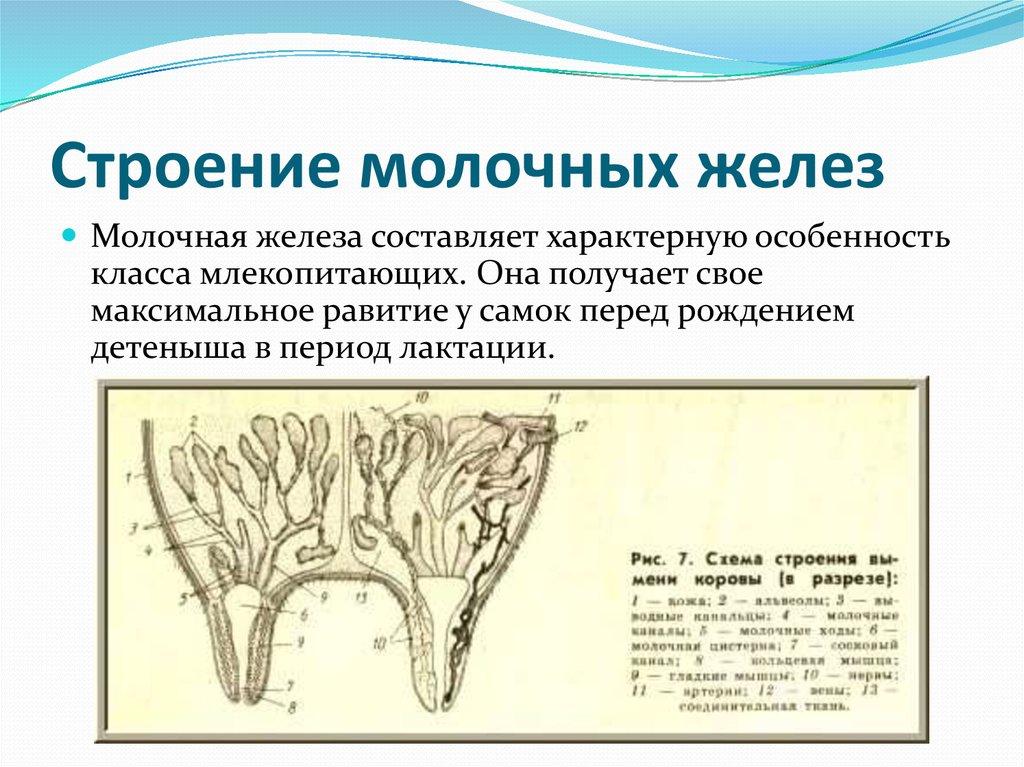
Purpose of milk follicles
The task of the follicles in the mammary glands is to remove milk. The liquid accumulated in the milk tanks flows out through the teat canals. The volume of follicles changes at different stages of a cow's life - during estrus, pregnancy, lactation.
Nipples
The length of the cow's teat is 8-10 cm, the diameter is 3 cm. The nipple is not only a channel for milk flow, but also protects the mammary glands from external infection. It is divided into apical, main, cylindrical parts and a body.
Tail
The vertebral skeleton ends with movable caudal vertebrae. The tail of a cow is long, whipping, with a brush at the end, intended for brushing off blood-sucking insects from the body. Cows are strong, hardy animals with a strong skeleton and well-developed muscles. The health of livestock depends on the correct functioning of organs and systems, which must be maintained with competent care, maintenance and feeding.
